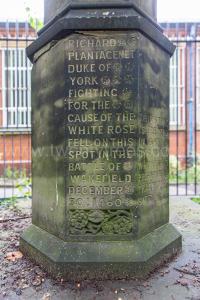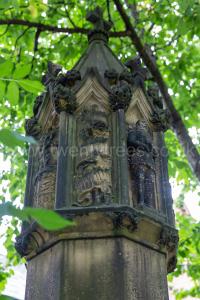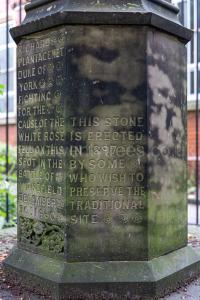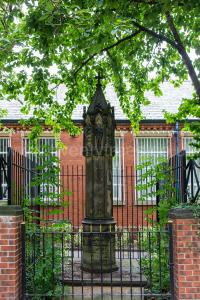Battle of Wakefield
Battle of Wakefield is in 1459-1461 Wars of the Roses: Second War.
Chronicle of Gregory 1460. 30 Dec 1460. Ande the same yere, the xxx [30] day of December, the Duke of Exceter (age 30), the Duke of Somersett (age 24), the Erle of Northehomberlond (age 39), the Lorde Roos (age 33), the Lorde Nevyle (age 50), the Lorde ClyfForde (age 25), with many mo lordys, knyghtys, squyers, and gentyllys, and the commyns of the Quenys party, met with the Duke of Yorke (age 49) at Wakefylde [Map], and there they made a grete jorney a-pon the Lorde and Duke of Yorke, and toke hym and the Erle of Saulysbury (age 60), the Erle of Rutlond (age 17), and the Lorde Haryngdon (age 18), and Syr Thomas Nevyle (age 30), and Syr Thomas Haryngdon (age 60), and many mo knyghtys were take a slayne by syde alle the comyns. But thys good Duke of Yorke with hys lordys a-fore sayde loste hyr heddys; God have marcy on there soulys, for they loste in that jorneys the nombyr of xxvc [2500] men. And in the Quenys party were slay but ii c [200] men, &c.







Chronicle of Gregory 1461. Then come tydyngys of the comynge of þea Erle of Marche (age 18) unto London; thenn alle the cytte were fayne, and thonkyd God, and sayde that
He that had Londyn for sake
Wolde no more to hem take,
and sayde, "Lette us walke in a newe wyne yerde, and lette us make us a gay gardon in the monythe of Marche with thys fayre whyte ros and herbe, the Erle of Marche (age 18)." And the Erle of Warwycke (age 32) mette with the Erle of Marche by-syde Oxforde, x myle owte of hit, at a towne of hys owne i-namyd Burford a-pon the Wolde [Map]; for the Erle of Marche come fro Walys, and was fulle sore a-ferde of the loste of the ij fyldys that were loste by-fore, Wakefylde that one, and Synt Albonys that othyr, and he sorowde sore for hys fadyr the Duke of Yorke (age 49), and for hys good brother the Erle of Rutlond (age 17), and for alle othyr lordys and comyns, &c.


Note a. the repeated in MS.
On 30 Dec 1460 the Lancastrian army took their revenge for the defeats of the First Battle of St Albans and the Battle of Northampton during the Battle of Wakefield at Sandal Castle [Map]. The Lancastrian army was commanded by Henry Holland 3rd Duke Exeter (age 30), Henry Beaufort 2nd or 3rd Duke Somerset (age 24) and Henry Percy 3rd Earl of Northumberland (age 39), and included John Courtenay 15th Earl Devon (age 25) and William Gascoigne XIII (age 30), both knighted, and James Butler 1st Earl Wiltshire 5th Earl Ormonde (age 40), John "Butcher" Clifford 9th Baron Clifford (age 25), John Neville 1st Baron Neville of Raby (age 50), Thomas Ros 9th Baron Ros Helmsley (age 33), Henry Roos and Thomas St Leger (age 20).







The Yorkist army was heavily defeated.
Richard Plantagenet 3rd Duke York (age 49) was killed. His son King Edward IV of England (age 18) succeeded 4th Duke York, 7th Richard Plantagenet 3rd Duke York (age 49), 9th Earl Ulster, 3rd Earl Cambridge.

Thomas Neville (age 30), and Edward Bourchier were killed.

Father and son Thomas Harrington (age 60) and John Harrington (age 36) were killed, the former dying of his wounds the day after.
William Bonville 6th Baron Harington (age 18) was killed. His daughter Cecily Bonville Marchioness Dorset succeeded 7th Baroness Harington.
Thomas Parr (age 53) fought in the Yorkist army.
Following the battle Richard Neville Earl Salisbury (age 60) was beheaded by Thomas "Bastard of Exeter" Holland. William Bonville (age 40) was executed.

Edmund York 1st Earl of Rutland (age 17) was killed on Wakefield Bridge [Map] by John "Butcher" Clifford (age 25) by which he gained his sobriquet "Butcher". Earl of Rutland extinct.

Croyland Chronicle 1476. 30 Dec 1461. After the conclusion of these matters, towards the close of the same year, it being the week of our Lord's Nativity, the said Bichard, duke of York, incautiously engaged the northern army at Wakefield which was fighting for the king, without waiting to bring up the whole of his own forces ; upon which, a charge was made by the enemy on his men, and he was without any mercy or respect relentlessly slain. There fell with him at the same place many noble and illustrious men ; and countless numbers of the common people, who had followed him, met their deaths there, and all to no purpose.
1897. Monument to Richard Plantagenet 3rd Duke York on Manygates Lane [Map] at the location where he is traditionally thought to have been killed at the Battle of Wakefield.



